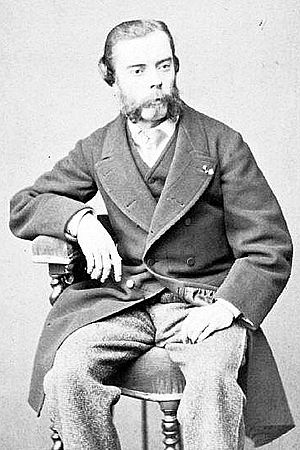Eugène Ketterer facts for kids
Eugène Ketterer (born July 7, 1831 – died December 18, 1870) was a French composer and a talented pianist. He was famous for writing many "salon arrangements" of popular opera songs. Salon arrangements were pieces of music made simpler or different so they could be played in people's homes, often for small concerts or gatherings.
Contents
Ketterer's Musical Journey
Eugène Ketterer was born in Rouen, France. His family originally came from Alsace. When he was young, he became a student at the famous Conservatoire de Paris, a top music school in Paris. There, he studied with a teacher named Antoine François Marmontel.
Ketterer was a bright student. In 1847, he won second prize for solfège, which is a way of learning to read and sing music notes. In 1852, he earned a "premier accessit," which is like a special honorable mention.
After he finished his studies, Ketterer became a very busy pianist. He performed often until he passed away in Paris in 1870. He became well-known for his "fantasies" and "drawing-room pieces." These were often short, imaginative musical works or pieces meant to be played in a home's drawing-room (a fancy living room). He wrote a huge number of these pieces, but only a few are still played today.
Ketterer's many works show us what kind of operas were popular in France during his time. This is because many of his pieces were "transcriptions" of famous opera songs. A transcription means he took a song from an opera and rewrote it for the piano, making it a solo piece. Many of these opera songs are still famous even now!
Other musicians, like Joseph Rummel and Édouard Mangin, sometimes took Ketterer's piano transcriptions and arranged them for two pianos to be played at once (called "piano 4-hands"). One collection of these arrangements, called "Les Étoiles" (The Stars), came out in 1875 and included 18 (later 19) pieces.
What Ketterer Composed
Eugène Ketterer wrote a lot of music, especially for the piano. He was known for taking popular opera tunes and turning them into exciting piano pieces.
Piano Works
Most of Ketterer's compositions were for the piano. He wrote many "fantasies" and "caprices," which are often free-form, imaginative pieces. He also composed many "valses" (waltzes) and "mazurkas" (a type of Polish dance). A big part of his work involved transcribing (rewriting for piano) famous songs from operas by composers like Verdi, Offenbach, Gounod, and Meyerbeer.
Here are a few examples of his piano works:
- Op. 21 - L'Argentine, a lively Mazurka
- Op. 45 - Fantaisie de concert pour le piano sur Oberon de Weber, a concert fantasy based on Weber's opera
- Op. 60 - Fantaisie brillante sur Martha, de Flotow, a bright fantasy on Flotow's opera
- Op. 115 - Illustrations sur Il trovatore, opéra de Verdi, pieces based on Verdi's opera
- Op. 145 - Fantaisie-transcription sur Rigoletto, opéra de Verdi, a fantasy transcription of Verdi's opera
- Op. 209 - Mignon, opéra d'Ambroise Thomas, a brilliant fantasy on Thomas's opera
- Op. 287 - La Marseillaise, de Rouget de Lisle, a brilliant version of the French national anthem
Songs
Ketterer also composed some songs, often setting poems to music.
- La Fleur des champs (The Field Flower), a villanelle (a type of poem) from 1854.
Chamber Works
He also wrote music for small groups of instruments, known as chamber music. These pieces often involved the piano along with another instrument like a violin or organ.
- (with Adolphe Herman) Grand duo brillant sur 'Le Pardon de Ploërmel', opéra de G. Meyerbeer, for violin and piano.
- (with Auguste Durand) L'Africaine', opéra de Meyerbeer, a brilliant duo for piano and organ.
- Don Carlos, Grand opéra de Verdi, Duo concertant pour piano et violon, a concert duo for piano and violin, co-written with Albert Vizentini.
Posthumous Works
Some of Ketterer's works were published after he passed away.
- La Favorite, de Donizetti, a fantasy published in 1874.
- Diadème-polka, a polka that was also arranged for piano 4-hands.


